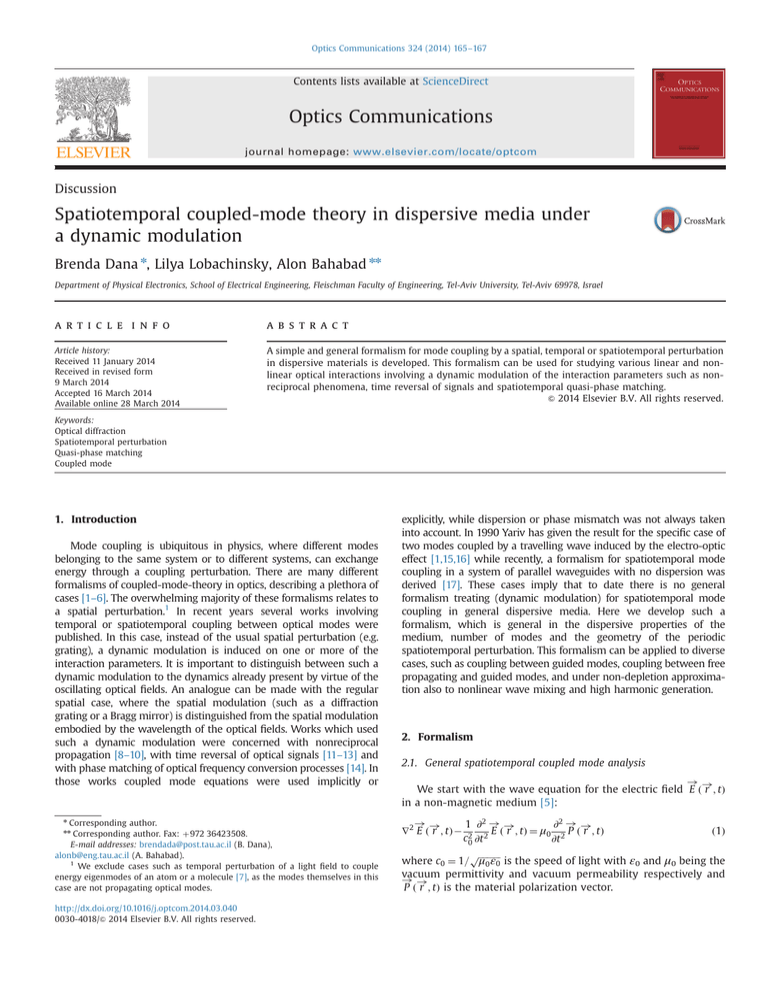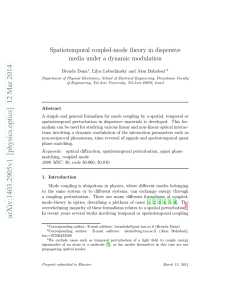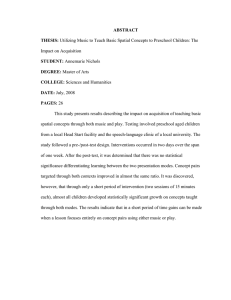
Optics Communications 324 (2014) 165–167
Contents lists available at ScienceDirect
Optics Communications
journal homepage: www.elsevier.com/locate/optcom
Discussion
Spatiotemporal coupled-mode theory in dispersive media under
a dynamic modulation
Brenda Dana n, Lilya Lobachinsky, Alon Bahabad nn
Department of Physical Electronics, School of Electrical Engineering, Fleischman Faculty of Engineering, Tel-Aviv University, Tel-Aviv 69978, Israel
art ic l e i nf o
a b s t r a c t
Article history:
Received 11 January 2014
Received in revised form
9 March 2014
Accepted 16 March 2014
Available online 28 March 2014
A simple and general formalism for mode coupling by a spatial, temporal or spatiotemporal perturbation
in dispersive materials is developed. This formalism can be used for studying various linear and nonlinear optical interactions involving a dynamic modulation of the interaction parameters such as nonreciprocal phenomena, time reversal of signals and spatiotemporal quasi-phase matching.
& 2014 Elsevier B.V. All rights reserved.
Keywords:
Optical diffraction
Spatiotemporal perturbation
Quasi-phase matching
Coupled mode
1. Introduction
Mode coupling is ubiquitous in physics, where different modes
belonging to the same system or to different systems, can exchange
energy through a coupling perturbation. There are many different
formalisms of coupled-mode-theory in optics, describing a plethora of
cases [1–6]. The overwhelming majority of these formalisms relates to
a spatial perturbation.1 In recent years several works involving
temporal or spatiotemporal coupling between optical modes were
published. In this case, instead of the usual spatial perturbation (e.g.
grating), a dynamic modulation is induced on one or more of the
interaction parameters. It is important to distinguish between such a
dynamic modulation to the dynamics already present by virtue of the
oscillating optical fields. An analogue can be made with the regular
spatial case, where the spatial modulation (such as a diffraction
grating or a Bragg mirror) is distinguished from the spatial modulation
embodied by the wavelength of the optical fields. Works which used
such a dynamic modulation were concerned with nonreciprocal
propagation [8–10], with time reversal of optical signals [11–13] and
with phase matching of optical frequency conversion processes [14]. In
those works coupled mode equations were used implicitly or
n
Corresponding author.
Corresponding author. Fax: þ 972 36423508.
E-mail addresses: brendada@post.tau.ac.il (B. Dana),
alonb@eng.tau.ac.il (A. Bahabad).
1
We exclude cases such as temporal perturbation of a light field to couple
energy eigenmodes of an atom or a molecule [7], as the modes themselves in this
case are not propagating optical modes.
nn
http://dx.doi.org/10.1016/j.optcom.2014.03.040
0030-4018/& 2014 Elsevier B.V. All rights reserved.
explicitly, while dispersion or phase mismatch was not always taken
into account. In 1990 Yariv has given the result for the specific case of
two modes coupled by a travelling wave induced by the electro-optic
effect [1,15,16] while recently, a formalism for spatiotemporal mode
coupling in a system of parallel waveguides with no dispersion was
derived [17]. These cases imply that to date there is no general
formalism treating (dynamic modulation) for spatiotemporal mode
coupling in general dispersive media. Here we develop such a
formalism, which is general in the dispersive properties of the
medium, number of modes and the geometry of the periodic
spatiotemporal perturbation. This formalism can be applied to diverse
cases, such as coupling between guided modes, coupling between free
propagating and guided modes, and under non-depletion approximation also to nonlinear wave mixing and high harmonic generation.
2. Formalism
2.1. General spatiotemporal coupled mode analysis
!!
We start with the wave equation for the electric field E ð r ; tÞ
in a non-magnetic medium [5]:
!!
1 ∂2 ! !
∂2 ! !
∇2 E ð r ; tÞ 2 2 E ð r ; tÞ ¼ μ0 2 P ð r ; tÞ
c0 ∂t
∂t
ð1Þ
pffiffiffiffiffiffiffiffiffiffi
where c0 ¼ 1= μ0 ε0 is the speed of light with ε0 and μ0 being the
vacuum permittivity and vacuum permeability respectively and
!!
P ð r ; tÞ is the material polarization vector.
166
B. Dana et al. / Optics Communications 324 (2014) 165–167
The polarization model we analyse assumes a complete separa!
tion between a linear transverse dispersive term χ ð1Þ ð r? ; tÞ and a
!
non-dispersive spatiotemporal perturbation term Δεð r ; tÞ. Here
!
!
r? ¼ ðx; yÞ and r ¼ ðx; y; zÞ. For simplicity we also assume that
both these terms are scalar. Unlike in regular spatial couple mode
!
!
theory in which Δε ¼ Δεð r Þ, the time dependence of Δεð r ; tÞ in
the present model allows to include a dynamic modulation as a
coupling agent between modes. Under these assumptions the
polarization vector assumes the form [18]
!!
! !
!!
P ð r ; tÞ ¼ P L ð r? ; tÞ þ Δ P ð r ; tÞ
!!
!
!
ð2Þ
¼ ½ε0 χ ð1Þ ð r? ; tÞ þ Δεð r ; tÞ E ð r ; tÞ
where n stands for convolution. Substituting the polarization term
given by Eq. (2) in Eq. (1) and applying a Fourier transform in the
time domain results in
^ !
^ !
!
!
2 !
∇2 E ð r ; ωÞ þ k ð r? ; ωÞ E ð r ; ωÞ
^ !
!
!
ð3Þ
¼ μ0 ω2 ½Δε^ ð r ; ωÞn E ð r ; ωÞ
^ !
!
!!
where E ð r ; ωÞ stands for the Fourier transform of E ð r ; tÞ and
ω2
ð1Þ !
2 !
k ð r? ; ωÞ ¼ ½1 þ χ^ ð r? ; ωÞ 2
c0
ð4Þ
In analogy with the case of having standard spatial perturbation [6], for the solution of the wave equation in the case of having
spatiotemporal perturbation we invoke a spatiotemporal variation
of constants in which the mode amplitudes are both spatially and
temporally dependent:
!!
! !
E ð r ; tÞ ¼ ∑am ðz; tÞ E m ð r? Þe iβm z þ iωm t
ð5Þ
m
! !
Here E m ð r? Þe iβm z þ iωm t are the normal modes of the system
satisfying the unperturbed Helmholtz wave equation given by [6]
2 ! !
2 !
ð6Þ
½∇?2 þ k ð r? ; ωm Þ βm E m ð r? Þ ¼ 0
In the frequency domain Eq. (5) can be written as
^ !
!
!
^ ω ωm Þ E m ð!
E ð r ; ωÞ ¼ ∑aðz;
r? Þe iβm z
m
ð7Þ
Assuming the coupling dynamic perturbation is periodic in
both space and time, we can represent it with a Fourier series
expansion:
!
Δεð!
r? ; tÞ ¼ ∑εp;q ð r? ÞeiqΩt ipKz ; p; q A Z
ð8Þ
p;q
where Ω and K are the temporal and spatial fundamental
frequencies of the modulation and the Fourier coefficients are
given by
Z π =Ω
Z
K Ω π =K
!
εp;q ð!
r? Þ ¼ 2
dz
dt Δεð r? ; z; tÞeiqΩt ipKz
ð9Þ
4π π =K
π =Ω
In the frequency domain the perturbation is written as
!
^
Δε ð!
r? ; ωÞ ¼ ∑ε^ p;q ð r? Þe ipKz δðω qΩÞ; p; q A Z
p;q
ð10Þ
Let us examine the expression:
^ !
!
2 !
k ð r? ; ωÞ E ð r ; ωÞ
ð11Þ
which appears in Eq. (3). Using Eq. (7) and assuming that the
^ ω ωm Þ are narrow-band relative to their respective
envelopes aðz;
carrier frequencies ωm such that they are spectrally isolated from
each other we can expand Eq. (11) in the dispersion terms as
!
2 !
^ ωÞaðz;
^ ω ωm Þ E m ð!
r? Þe iβm z
ð12Þ
∑½k ð r? ; ωm Þ þ Dð
m
^ ωÞ ¼ ∑1 ð1=l!Þð∂l k2 ð!
r? ; ωÞ=∂ωl Þjω ¼ ωm ðω ωm Þl is the
where Dð
l¼1
dispersion operator in the frequency domain.
We further make a functional approximation in which the
dispersion terms are spatially independent. This way the spatial
2 !
dependence of k ð r? ; ωÞ accounts for the guiding properties of the
system, while the dispersive terms are defined within a volume of
2
interest (such as the core of a wave-guide). Thus, ð∂l =∂ωl Þk
!
l
l 2
ð r? ; ωÞjω ¼ ωm ffi ð∂ =∂ω Þk ðωÞjω ¼ ωm .
Substituting Eqs. (6)–(7), (10) and (11) into Eq. (3), while using
a spatially slowly varying envelope approximation (SVEA)
jð∂2 =∂z2 Þam ðz; tÞj⪡jβm ð∂=∂zÞam ðz; tÞj, we get
! !
∂
^ ωÞa^ m ðz; ω ωm Þ
∑ E m ð r? Þe iβm z 2iβm a^ m ðz; ω ωm Þ þ Dð
∂z
m
!
2
¼ μ0 ω ∑ε^ p;q ð r? Þe ipKz δðω ωn Þ
p;q
! !
n∑ E n ð r? Þa^ n ðz; ω ωn Þe iβn z
n
ð13Þ
We use the usual normalization for a 1 W power flow in the
propagation direction which results in the orthogonality relation
[6]:
! ! ! !
⟨ E m ð r? Þ E n ð r? Þ⟩
Z
2 ωm μ
!! ! ! !
δmn
ð14Þ
¼
d r ? E m ð r ? Þn E n ð r ? Þ ¼
jβm j
where ⟨ j ⟩ stands for inner product and δmn is either the
Kronecker delta function for bound modes or the Dirac delta
function for radiation modes. With this orthogonality condition we
project Eq. (13) on a specific mode ⟨mj to get
2ωm iβm z
∂
^ ωÞa^ m ðz; ω ωm Þ
e
2iβm a^ m ðz; ω ωm Þ þ Dð
∂z
jβ m j
iðβn þ pKÞz ^
a n ðz; ω ωn Þnδðω qΩÞ
¼ ω2 ∑∑C pq
mn e
n p;q
with the coupling coefficient:
Z
!! !
! ! !
d r? E m ð r? Þnε^ p;q ð r? Þ E n ð r? Þ
C pq
mn ¼
ð15Þ
ð16Þ
Transforming back to the time domain Eq. (15) takes the form
∂
1
DðtÞ am ðz; tÞ
∂z 2iβ m
¼
jβ m j
∂2
∑∑C pq e iðβn βm þ pKÞz e iωm t 2 an ðz; tÞeiðωn þ qΩÞt
4iωm β m n p;q mn
∂t
ð17Þ
l
l
l
l
1
where DðtÞ ¼ ∑1
l ¼ 1 ðð iÞ =l!Þ∂ k ðωÞ=∂ω jω ¼ ωm ∂ =∂t ¼ ∑l ¼ 1 ð2kðωm Þ
ð iÞl =l!Þð∂l kðωÞ=∂ωl jω ¼ ωm Þ∂l =∂t l is the dispersion operator in the
time domain [19].
Eq. (17) is the major result of this paper. Unlike in regular
spatial perturbation mode coupling, this result includes the effect
of a periodic applied dynamic modulation through the appearance
of the qΩ temporal frequencies.
If we now further assume a second-order temporal SVEA:
jð∂2 =∂t 2 Þan ðz; tÞj⪡jωn ð∂=∂tÞan ðz; tÞj⪡jω2n an ðz; tÞj and that jqΩj is
much smaller than ωn we are left with
∂
1
iΔωm;n;q t iΔkm;n;q z
DðtÞ am ðz; tÞ ¼ κ m ∑∑C pq
e
ð18Þ
mn an ðz; tÞe
∂z 2iβ m
n p;q
l 2
with κ m ¼ ijβ m jðωn þ qΩÞ2 =4ωm β m and where Δkm;n;q ¼ β n βm þ
pK is the momentum phase mismatch and Δωm;n;q ¼ ωn ωm þ qΩ
is the energy phase mismatch. This form is appealing as the spatial
and temporal phase mismatch terms appear with the same
functional form. The appearance of the temporal phase mismatch
is the result of allowing for a dynamic modulation. This term does
not appear in regular – spatial coupled mode theory.
B. Dana et al. / Optics Communications 324 (2014) 165–167
2.2. The special case of two coupled modes under first order
dispersion approximation
Eq. (18) describes a general case of mode coupling caused by
temporal and/or spatial perturbations in dispersive media. In
many cases of interest there are only two coupled modes (there
might be other modes but the coupling with these other modes is
negligible) and only the first dispersion term is important. Let the
two coupled mode be designated with the indices 1 and 2. We
assume that the coupling is made through a specific (p, q) order of
the perturbation. In this case the coupled mode equations reduce
to
∂ kðω1 Þ 1
∂
iΔωt iΔkz
þ
a ðz; tÞ ¼ κ 1 C p;q
e
ð19Þ
12 a2 ðz; tÞe
∂z
β1 vg ðω1 Þ ∂t 1
∂ kðω2 Þ 1
∂
þ
a ðz; tÞ
∂z
β2 vg ðω2 Þ ∂t 2
n
iΔωt iΔkz
¼ κ 2 ðC p;q
e
12 Þ a1 ðz; tÞe
ð20Þ
with the phase mismatch components Δk ¼ β 2 β1 þ pK and
p; q
n
Δω ¼ ω2 ω1 þ qΩ. We have used the relation C 21
¼ ðC p;q
12 Þ
which is easily derived from Eq. (16). In addition we used
2
ð∂=∂ωÞk ðωÞjω ¼ ωm ¼ 2ðkðωm Þ=vg ðωm ÞÞ with the usual definition of
the group velocity vg 1 ðωÞ ¼ ð∂=∂ωÞkðωÞ.
We would like to comment that these last two equations can be
further reduced to known cases in the literature. With no temporal
modulation: Δω ¼ 0 and qΩ ¼ 0, they reduce to regular spatial
coupled mode [1,4]. For the case of nonlinear frequency conversion under the non-depletion approximation, with temporal
modulation, Eq. (20) is virtually identical in form to Eq. (2) in
Ref. [14]; with no temporal modulation this same equation is
reduced to the form found in Eq. (2.7.11) in Ref. [21].
3. Discussion
In this work we developed a general coupled-mode formalism
under the presence of a dynamic modulation leading to a temporal
or a spatiotemporal perturbative coupling of modes. This dynamic
modulation is absent from regular spatial optical coupled mode
theory. This generalization can not only describe known phenomena such as optical non-reciprocity and time reversal but it can
also lead to new ones – such as the formation of a breathing
soliton pair with no nonlinearity [20].
167
Our model is not restricted to any specific system or mechanism for inducing the perturbation. It applies to any number of
modes, as well as to a continuum of modes. It includes high order
dispersion terms. The model requires that the coupling perturbation can be approximated as non-dispersive, compared to the
linear susceptibility term, as is explicit in Eq. (2). This condition is
satisfied for example when the perturbation is applied through the
electrooptic effect. This can be proved using Miller's rule [21]
applied to the electrooptic nonlinear polarization term. Another
implicit required condition is that the perturbation spatial and
temporal modulations are much slower than those of the optical
frequencies of the relevant modes. Otherwise the problem
becomes one of effective medium approximation.
References
[1] A. Yariv, IEEE J. Quant. Electron. 9 (September (9)) (1973) 919.
[2] H.A. Haus, W.-P. Huang, S. Kawakami, N. Whitaker, J. Lightwave Technol. 5
(January (1)) (1987) 16.
[3] Amos Hardy, William Streifer, J. Lightwave Technol. 3 (October (5)) (1985)
1135.
[4] Shun-Lien Chuang, IEEE J. Quant. Electron. 23 (May (5)) (1987) 499.
[5] B.E.A. Saleh, M.C. Teich, Fundamentals of Photonics, Wiley Series in Pure and
Applied Optics, John Wiley & Sons, New Jersey, USA, 2007.
[6] A. Yariv, P. Yeh, Photonics: Optical Electronics in Modern Communication. The
Oxford Series in Electrical and Computer Engineering Series, Oxford University
Press, New York, USA, 2007.
[7] P.W. Milonni, J.H. Eberly, Laser Physics, Wiley, New Jersey, USA, 2010.
[8] M.S. Kang, A. Butsch, P.St.J. Russell, Nat. Photonics 5 (9) (2011) 549.
[9] H. Lira, Z. Yu, S. Fan, M. Lipson, Phys. Rev. Lett. 109 (3) (2012) 33901.
[10] Z. Yu, S. Fan, Nat. Photonics 3 (2) (2009) 91.
[11] Yonatan Sivan, John B Pendry, Phys. Rev. Lett. 106 (19) (2011) 193902.
[12] Mehmet Fatih Yanik, Shanhui Fan, Phys. Rev. Lett. 93 (October) (2004) 173903.
[13] Stefano Longhi, Phys. Rev. E 75 (February) (2007) 026606.
[14] A. Bahabad, M.M. Murnane, H.C. Kapteyn, Nat. Photonics 4 (8) (2010) 571.
[15] Guoliang Zheng, Weilong She, Opt. Commun. 268 (2) (2006) 323.
[16] A. Yariv, Optical Electronics. The Oxford Series in Electrical and Computer
Engineering Series, Oxford University Press, New York, USA, 1990.
[17] Vladislav R. Shteeman, Inna Nusinsky, Amos A Hardy, J. Opt. Soc. Am. B 27 (4)
(2010) 735.
[18] Tian Feng, Y.-Z. Wu, P.-D. Ye, IEEE J. Quant. Electron. 24 (3) (1988) 531.
[19] A. Weiner, Ultrafast Optics, Wiley Series in Pure and Applied Optics, Wiley,
New Jersey, 2011.
[20] B. Dana, B. Malomed, A. Bahabad, Breathing solitary-pulse pairs in a linearly
coupled system, Opt. Lett. (2014), to be published, http://arxiv.org/pdf/1403.
1031.pdf.
[21] R.W. Boyd, Nonlinear Optics, Electronics & Electrical, Academic Press, USA,
2003.




